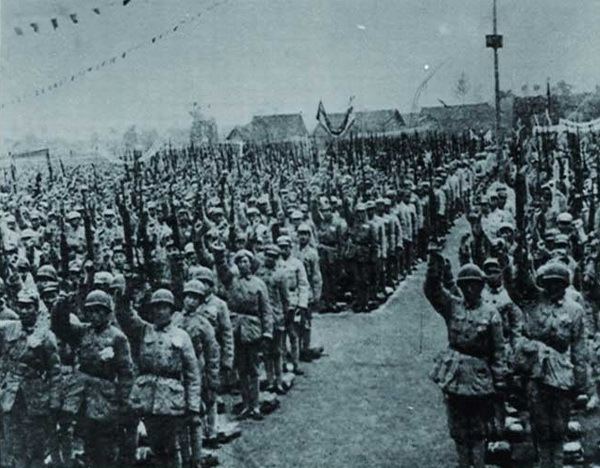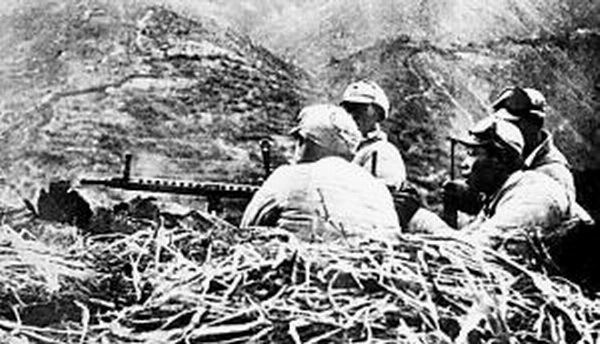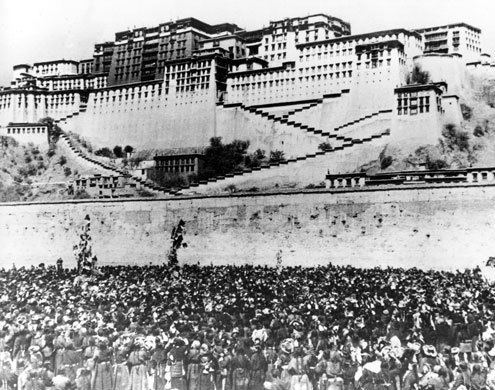180 killed or wounded 114 killed or wounded Result Chinese victory | Start date October 1950 | |
 | ||
Similar Incorporation of Tibet into the Peopl, 1959 Tibetan uprising, British expedition to Tibet, Sino‑Tibetan War, Sino‑Indian War | ||
Gorguts the battle of chamdo
The Battle of Chamdo (Chinese: 昌都战役), or known officially in China as the Liberation of Chamdo (Chinese: 解放昌都), was a military campaign by the People's Republic of China (PRC) against a de facto independent Tibet in Chamdo after months of failed negotiations. The campaign aimed to capture the Tibetan army in Chamdo, demoralize the Lhasa government and to most importantly exert pressure to get Tibetan representatives to agree to negotiations in Beijing and sign terms recognizing China's sovereignty over Tibet. The campaign resulted in the capture of Chamdo and further negotiations between the PRC and Tibetan representatives that eventually resulted in the incorporation of Tibet into the People's Republic of China.
Contents

Gorguts the battle of chamdo
Background

On 7 March 1950, a Tibetan government delegation arrived in Kalimpong to open a dialogue with the newly declared PRC and aimed to secure assurances that the PRC would respect Tibet's “territorial integrity”, among other things. The dialogue was delayed by a debate between the Tibetan, India, Britain and the PRC delegation over the location of the talks. Tibet favored Singapore or British Hong Kong, Britain favored New Delhi, India, and the PRC favored Beijing, but India and Britain preferred no talks at all.

The Tibetan delegation eventually met with the PRC’s ambassador General Yuan Zhongxian in Delhi on September 16, 1950. Yuan communicated a 3-point proposal that Tibet be regarded as part of China, that China be responsible for Tibet’s defense, and that China was responsible for Tibet’s trade and foreign relations. Acceptance would lead to peaceful "liberation", or otherwise war. The Tibetans undertook to maintain the relationship between China and Tibet as one of preceptor and patron, and their head delegate Tsepon W. D. Shakabpa, on September 19, recommended cooperation, with some stipulations about implementation.

Chinese troops need not be stationed in Tibet, it was argued, since it was under no threat, and if attacked by India or Nepal could appeal to China for military assistance. While Lhasa deliberated, Chinese troops advanced into eastern Tibet on 7 October 1950, crossing the de facto border across 5 places. The purpose was to capture the Tibetan army in Chamdo, demoralize the Lhasa government, and exert enough pressure to send negotiators to Beijing to sign terms for a peaceful incorporation of Tibet.

On 21 October, Lhasa instructed its delegation to leave immediately for Beijing for consultations with the Communist government, and to accept the first provision if the status of the Dalai Lama could be guaranteed, while rejecting the other two conditions. It later rescinded even acceptance of the first demand, after a divination before the Six-Armed Mahākāla deities indicated that the three points could not be accepted, since Tibet would fall under foreign domination.
Invasion of Kham region

The Kham people barely opposed the initial Communist assault and occupation of Chamdo by the People's Liberation Army (PLA). Pandatsang Rapga, leader of the pro Kuomintang Tibet Improvement Party offered the governor of Chamdo, Ngabo Ngawang Jigme, some Khampa fighters in exchange for the Tibetan government recognizing the independence of Kham. Ngabo refused the offer.
After the defeat of the Tibetan Army in Chamdo, Rapga started mediating in negotiations between the PLA and the Tibetans.
Rapga and Topgay engaged in negotiations with the Chinese during their assault on Chamdo. The Kham people were known historically for their fierceness and warlike nature. Their natural reaction was to oppose and fight foreign domination arising from newly formed Communist China. However, with serious lack of weapons, the Kham were soon overwhelmed by numerically superior PLA forces. Despite being defeated at Chamdo, Kham fighters continued their opposition to the foreign invading forces. Local warlords soon became united under a common objective and hence resulted in the formation of Chushi Gangdruk with the assistance from CIA.
The Kham Tibetans and Lhasa Tibetans held each other in mutual contempt and dislike, with the Kham in some cases hating Lhasa rule even more than Chinese rule, which was why the Kham people did little to resist Chinese forces as they entered Kham and subsequently took over the entire Tibet. The Qinghai (Amdo) Tibetans view the Tibetans of Central Tibet (Tibet proper, ruled by the Dalai Lamas from Lhasa) as distinct and different from themselves, and even take pride in the fact that they were not ruled by Lhasa ever since the collapse of the Tibetan Empire.
Invasion of Chamdo
After months of failed negotiations, attempts by Tibet to secure foreign support and assistance, and the troop buildups by the PRC and Tibet, the People's Liberation Army (PLA) crossed the Jinsha River on 6 or 7 October. Two PLA units quickly surrounded the outnumbered Tibetan forces and captured the border town of Chamdo by 19 October, by which time 114 PLA soldiers and 180 Tibetan soldiers had been killed or wounded. Writing in 1962, Zhang Guohua claimed "over 5,700 enemy men were destroyed" and "more than 3,000" peacefully surrendered. Active hostilities were limited to a border area controlled by the Government of Tibet northeast of the Gyamo Ngul Chu River and east of the 96th meridian. After capturing Chamdo, the PLA ceased hostilities and sent a captured commander, Ngabo, to Lhasa to reiterate terms of negotiation, and waited for Tibetan representatives to respond through delegates to Beijing.
After confiscating their weapons, the PLA soldiers gave the prisoners lectures on socialism and a small amount of money, before allowing them to return to their homes. According to the Dalai Lama, the PLA did not attack civilians.
Aftermath
The PLA sent released prisoners (among them Ngapoi Ngawang Jigme, a captured Tibetan governor) to Lhasa to negotiate with the Dalai Lama on behalf of PLA. Chinese broadcasts promised that if Tibet was "peacefully liberated", the Tibetan elites could keep their positions and power. The Government of Tibet then sent representatives to Beijing to negotiate. The Seventeen Point Agreement was eventually signed between the Chinese and the Tibetans.
